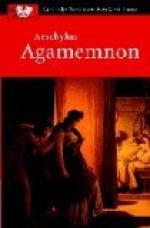I.
TANTALUS | Pelops | --------------------------- | | Atreus Thyestes | | ----------------- | | | | Agamemnon Menelaus Aigisthos (= Clytemnestra) (= Helen) (= Clytemnestra) | ------------------------ | | | Iphigenia Electra Orestes
(Also, a sister of Agamemnon, name variously given, married Strophios, and was the mother of Pylades.)
II.
Tyndareus = Leda = Zeus | | ----------- ------------------------- | | | | Clytemnestra Castor Polydeuces Helen
P. 1, l. 1.]—The Watchman, like most characters in Greek tragedy, comes from the Homeric tradition, though in Homer (Od. iv. 524) he is merely a servant of Aigisthos.
P. 2, l. 28, Women’s triumph cry.]—This cry of the women recurs several times in the play: cf. p. 26, ll. 587 ff., p. 55, l. 1234. It is conventionally represented by “ololu”; as the cry to Apollo, Paian is “I-e,” l. 146, and Cassandra’s sob is “ototoi” or “otototoi,” p. 47.
Pp. 3 f., ll. 40 ff.]—With this silent scene of Clytemnestra’s, compare the long silence of Cassandra below, and the silence of Prometheus in that play until his torturers have left him. See the criticism of Aeschylus in Aristophanes, Frogs, ll. 911-920, pp. 68, 69 in my translation.
P. 5, l. 104, Sign of the War-Way.]—i.e. an ominous sign seen by the army as it started on its journey. In Homer, Iliad, ll. 305-329, it is a snake which eats the nine young of a mother bird and then the mother, and is turned into stone afterwards.—All through this chorus the language of the prophet Calchas is intentionally obscure and riddling—the style of prophesy.
P. 7, l. 146, But I-e, i-e.]—(Pronounce Ee-ay.) Calchas, catching sight in his vision of the further consequences which Artemis will exact if she fulfils the sign, calls on Apollo Paian, the Healer, to check her.
P. 7, l. 160, Zeus, whate’er He be.]—This conception of Zeus is expressed also in Aeschylus’ Suppliant Women, and was probably developed in the Prometheus Trilogy. See my Rise of the Greek Epic, p. 291 (Ed. 2).
It is connected with the common Greek conception of the Tritos Soter— the Saviour Third. First, He who sins; next, He who avenges; third, He who saves. In vegetation worship it is the Old Year who has committed Hubris, the sin of pride, in summer; the Winter who slays him; the New Year which shall save. In mythology the three successive Rulers of Heaven are given by Hesiod as Ouranos, Kronos, Zeus (cf. Prometheus, 965 ff.), but we cannot tell if Aeschylus accepted the Hesiodic story. Cf. note on l. 246, and Clytemnestra’s blasphemy at l. 1387, p. 63.




